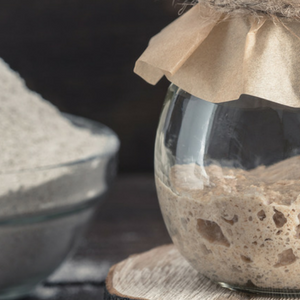
Gertrude (Sourdough Starter)
Least costly(both financially and time-wise) and easiest way to create a robust sourdough starter!
Ingredients
- 1 tbsp dry yeast active (1 packet= 1 tbsp)
- 1 cup coconut milk organic (not canned), room temperature (if you tolerate dairy, cow’s milk can be substituted)
- 1/2 cup sorghum flour (oat or quinoa flour can be substituted)
- 1/2 cup millet flour oat, teff or quinoa flour can be substituted)
- 1 tsp maple syrup or honey
Instructions
- In a glass 1 or 2 quart-jar, or in a glass bowl that will hold 4 to 8 cups, add the yeast to the room temperature milk and stir with a wooden spoon to dissolve the yeast. The spoon must be wood, not metal; yeasts do not like metal – it really stresses them out.
- Add your flours and maple syrup and stir to mix well.
- Cover the jar loosely with a thin, breathable dish towel (that old, worn out, but clean, favorite dish-towel you haven’t been able to bring yourself to consign to the pile of rags in the garage) or a piece of cheesecloth. If you use cheesecloth, it won’t be long enough to drape fully over the top of the jar, so keep it in place with a rubber band).
- Let the jar sit in a warm place (around 70-75 degrees) away from drafts for 2-3 hours. Now that Fall’s cool weather is here, I create a warm place for my starter by putting it next to the corner wall of my kitchen counter and placing our slow cooker, which I leave on its “warm” setting, in front of it. You could set your starter on top of the refrigerator or on your stove top, which will warm up if you turn on the oven at its lowest temperature.
- After 3-4 hours, your starter should start to bubble and will appear pockmarked on the surface. If it hasn’t already, in another hour or so, it will develop a thin layer of clear liquid on top. This thin liquid layer is called “hooch,” and is a good sign that your yeast has fed and produced acetic acid, the byproduct of yeasts’ fermentation that gives sourdough its tangy flavor. Just stir to incorporate the hooch back into the mixture, cover the jar (or bowl) again loosely, feed your starter with another ¼ cup of flour (and another ¼ cup of water if adding ¼ cup of flour makes the starter too thick to stir well), and let it sit out overnight. Remember to keep your starter warm (70-75 degrees).
- For the next 2 days, repeat this procedure. Once in the morning, once in the evening, stir the hooch back in, mix in ¼ cup of flour and if needed, ¼ cup of water, cover the starter loosely and leave it on the counter in a place where it will be kept warm (~70 degrees).
- The morning of Day 3, if you’re not going to bake a loaf of sourdough bread that day, just transfer your starter to the refrigerator. It will go into hibernation mode until it is removed from the refrigerator and fed. And then it will need about 4 hours to become bubbly and active again.
Notes
I use Bob's Red Mill gluten-free flours, which are available in most grocery stores and online.
Nutrition
Calories: 932kcalCarbohydrates: 103gProtein: 20gFat: 53gSaturated Fat: 43gSodium: 49mgPotassium: 932mgFiber: 9gSugar: 3gVitamin C: 2.2mgCalcium: 41mgIron: 11.9mg
Tried this recipe?Let us know how it was!